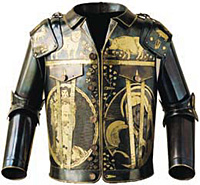 |
|
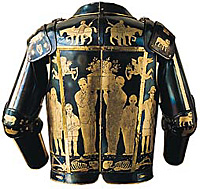 |
|
|
 |
|
 |
|
Extracts from a personal text.... ... The big problem about wanting to be an artist in Ireland is one of role models. When I eventually found myself on the precipice of my school days and career masters loomed and 'how to write a letter to a prospective employer' lessons were given, all I could see around me were boys who were preparing themselves for apprenticeships in Mackies or the Shipyard. My father had been a 'driller' in the yards but my nearest contact with what he actually did was the mosaic of metal shavings embedded in the soles of his boots, or the rust spots that stained his handkerchiefs. I was well down the slippery slope to my career choice long before I actually met an artist... ... I can't say for certain that going to art college was a mistake. Not many people realise this but you don't actually learn anything at art college anymore; however, you do have to go there to find that out. Self-taught artists often have a sense of inferiority which comes from the feeling that they have missed out on something crucial, and for that reason I am glad that I went, but it was an experience that nearly knocked the art out of me... | |
|
... The rot didn't begin to set in until I started my diploma course in that big impersonal glass cube beside the cathedral in central Belfast. I had been awarded one of those rare places on the fine art course -- ironically, competition was the stiffest for the department with the worst career prospects -- and was 'raring to go'. So what went wrong ? | |
|
... All of this heightened the feeling of being in the hinterland, of always being on the periphery of what was really important; it wasn't until nearly two decades later that I began to shake off that feeling.... ... By the time I left college I knew deep down that art couldn't really change things, that painting and sculpture could make no headway in the mayhem that was raging now in the sleepy city I grew up in. Rapid social changes required a more immediate art form and some of my contemporaries ended up making film and video productions. I became interested in print media and with money from a summer job in a bakery and the help of a small community press I published my first 'work'... .... Around about the same time two significant things happened, I got a job as a graphic designer and also became involved with a group of cartoonists in the publication of a satirical magazine -- 'The Peoples Comic'. My contributions to the comic included a story about the formation of a Loyalist Navy and a strip explaining how to tell the difference between Catholics and Protestants. The now legendary resilience of the Belfast people to adversity was forming itself along with a wry black humour which was perhaps the only means of survival for the creative spirit during the dark days of the mid-seventies. None of us had any illusions at this stage, about putting out material that would make the bigots see the error of their ways; it was simply a matter of staying afloat and these satires were the weapons that protected our own dignity.... ... The firm that I worked for was occasionally commissioned to do signage in mosaic, and although we didn't do anything more elaborate than some ornate lettering, I became intrigued by the pictorial possibilities of the medium and began to look into its history. It was like discovering a tomb or a lost city under what you thought were the foundations of your culture. Mosaic, by turning out to be one of the oldest of permanent mediums in our civilisation, helped me to understand the importance of creating unique and physically tangible works of art even in this century of change and turmoil. My argument throughout my college years against the fine art object was that it had no relevance to the vast majority of the population. Original art could only be shown in galleries and museums and could only be bought by the wealthy. This, of course, was all true but here were these incredible pre-Christian images still speaking to us volubly several millennia after their creation, while the average life span of a 20th century media image was about 48 hours.... Dublin, Ireland - December, 1994 | |
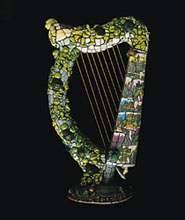 |
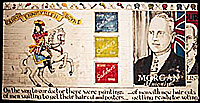 |
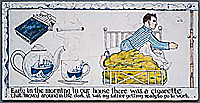 |